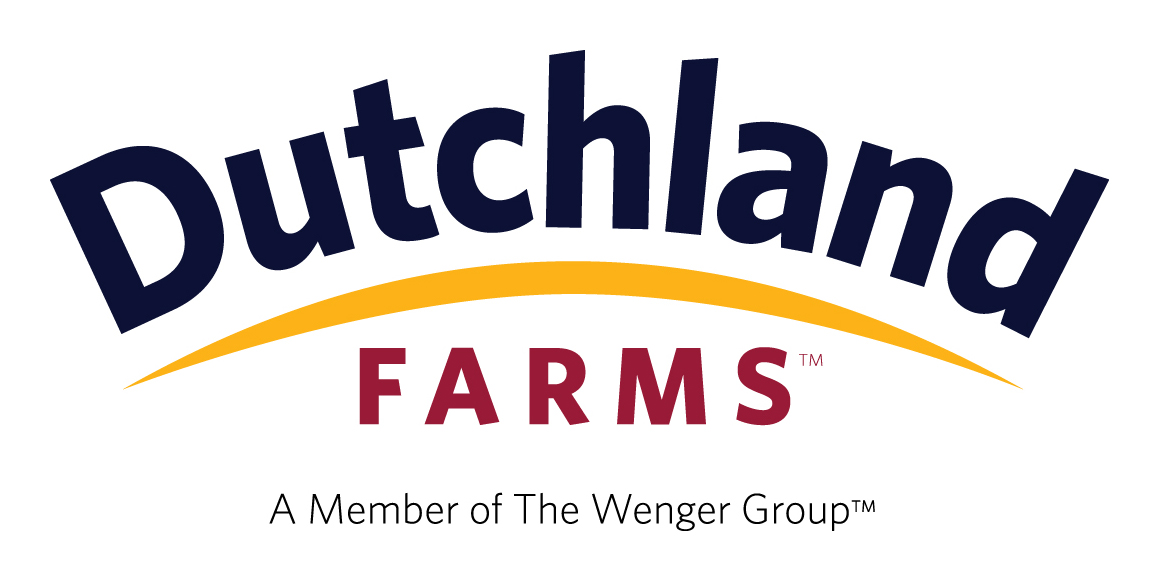Eric Gingerich, D.V.M.
Technical Service Specialist, Poultry
Since I wrote an article on this subject for The Wenger Group in 2008, a lot has changed in the prevalence and control of this disease. Colibacillosis or Escherichia coli (E. coli) infections in egg-type chickens continues as one of the top five disease issues in pullets and layers, it’s prevalence and significance of losses has declined.
The Disease
E. coli infections show up in flocks in five different syndromes or stages of life; 1) chicks, 2) growing pullets, 3) early lay period, 4) late lay of first cycle, and 5) at the onset of production post-molt.
Chicks – In chicks, the hatchery is normally the sources of E. coli infections that typically result in mortality the first 3 to 4 days of life. Chicks usually have a full crop and lesions seen are omphalitis and yolk infections as seen below:
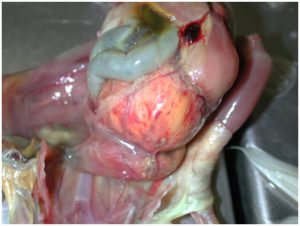
3 day old chick with yolk infection
Growing pullets – Pullets during growing become susceptible to secondary E. coli infections following stressors such as respiratory vaccinations, handling, high ammonia, high dust levels, etc. The lesions seen in birds dying from colibacillosis in this case include caseous airsacculitis, caseous peritonitis, caseous perihepatitis, or caseous pericarditis.
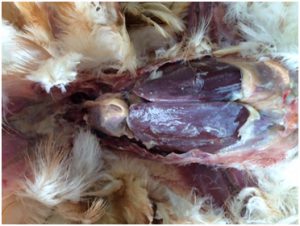
Pullet with caseous perihepatitis and pericarditis
Early Lay – E. coli infections in early lay are the most significant and can be the most devastating with some flocks in the past losing as many as 10% in one day. Today, with the use of better housing conditions and preventative measures, these losses are much, much less. I estimate that fewer than 5% of flocks experience this syndrome now compared to as much as 40% 10 years ago. Many factors can enter into the causation of this syndrome that typically leads to higher than desired mortality in the age range of 22 to 26 weeks of age. A list of some of these possible factors is as follows:
- Stress of the onset of egg production
- Changes in feeding patterns or feed ingredients
- Bacterial contamination of water (use of untreated pond water, well contamination, water line contamination, biofilms)
- High atmospheric ammonia
- Respiratory disease exposure after move to lay (Mycoplasma gallisepticum, M. synoviae, infectious bronchitis, etc.)
- High bird density
- Vent trauma from cannibalism
- High bird activity level leading to broken egg/shell membrane retention in shell gland
- Excessive dust
- Drinking out of puddles (cagefree outdoor access flocks)
- Dead birds not picked up prior to decomposition
Lesions typically are only of a caseous peritonitis unless there is a respiratory component in which more caseous pericarditis and perihepatitis will be seen. Birds still on feed and in production are typically lost indicating a very acute death.
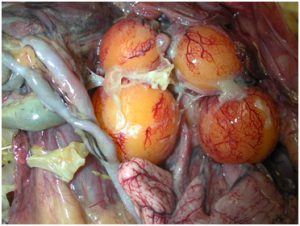
Caseous peritonitis in a layer
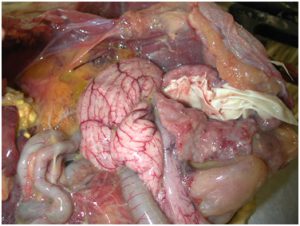
Retained Shell Membrane in Shell Gland
An uncommon occurrence of either Salmonella spp. or Pasteurella multocida infections may appear with lesions exactly like those of E. coli. Lab confirmation will be needed to confirm that the infection is due to E. coli should vaccination with live E. coli vaccine be considered as one of the interventions for treatment.
Late Lay cycle – Late lay problems from E. coli infections are part of the normal increase in late lay mortality due to more birds going in and out of production, poor feathering, and more vent pecking leading to oviduct infections. Birds that come out of production after a long clutch or birds that are unable to compete have regressing ovaries that are very fragile and ova break easily. This yolk in the peritoneal cavity serves as a great medium for E. coli growth and the bird dies of septicemia.
Birds dying from colibacillosis in late lay are normally out of production and smaller than the average.
Another factor in the late lay colibacillosis incidence is pecking activity. Feather loss has a big impact on late lay mortality as birds with poor feathering have less protection against wounds and it leads to more pecking activity and vent trauma. Any wounding leads to an introduction of bacteria into the body that leads to peritonitis or oviduct infections.
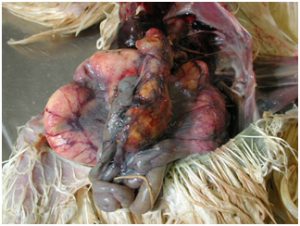
Caseous Salpingitis (Oviduct Infection)
Post-molt – Post-molt flocks may have outbreaks of colibacillosis as well just as do first cycle flocks just coming into production.
Prevention
With the above causative factors in mind, the following list of preventative measures is produced:
- Water –
- Assure a potable water supply at the water consumption point.
- Between flocks, clean water lines for removal of biofilms and follow with a good sanitation program.
- Continuous chlorination systems have become more commonplace and have effectively lowered problem with colibacillosis. This is especially important for operations that use pond water.
- Test wells for contamination twice a year. Correct the problem if found contaminated.
- Eliminate water puddles in flocks with outdoor access.
- If water founts or troughs are used, daily cleanout and disinfection with chlorine or iodine disinfectant is recommended.
- Air quality –
- Newer manure belt housing has led to improved air quality compared to the high-rise houses of the past.
- Cagefree operations and old high-rise houses continue to have excess ammonia in the air in winter
- Dust can carry fecal E. coli and increase the challenge to the bird through respiratory and feed contamination. The weekly or bi-weekly use of a disinfectant dust in the litter of cagefree flocks may aid in reducing the harm from dust.
- Avoiding dust blowing in cage houses where an excess of dust will result. Sweeping may be a better option.
- Dead bird pickup –
- Remove dead birds from the house daily. Be thorough, as decomposing dead birds will exude significant amounts of pathogenic bacteria.
- Bird space –
- The use of high-density cage housing is still practiced in some housing where egg customers have not required lower densities.
- Respiratory disease prevention –
- Using a complete, veterinarian approved vaccination program to prevent possible respiratory diseases to which the layers may be exposed, will aid greatly in reducing problems at all stages.
- Utilize vaccine supplier company’s technical people to routinely evaluate vaccine administration procedures.
- Continually evaluate respiratory disease exposure levels in all flocks.
- Move pullets to the lay house at least one week before first egg to allow the birds to be exposed to new respiratory agents prior to heavy egg production.
- Feathering –
- Continually evaluate flocks for feather cover and inform the nutritionist of these findings for him to better formulate accordingly.
- Routinely evaluate beak trimming quality as well as a factor in feather cover
- Maintaining an optimum microflora –
- Utilize fermentation metabolite, probiotic, prebiotic, and other intestinal health aids that improve the quality of the microflora to lower levels of pathogens such as E. coli. This is especially important for newly housed pullets in the layer house as they are in new surroundings and exposed to a new set of pathogens.
- Minimize any changes in feed ingredients, feeding pattern, or nutrient levels during early lay as this may negatively alter the makeup of the microflora.
- Vaccination for coli –
- This live vaccine has been a very surprisingly effective product and has helped reduce the prevalence of colibacillosis greatly in egg layers.
- Normally, two applications of the vaccine during growing will prevent a majority of the problems experienced under normal conditions. Spray, water, or eyedrop application is being done with eyedrop the preferred method as it ensures the best coverage. E. coli vaccine does not spread among flock members following the 4 to 5 day incubation period as do the respiratory viral vaccines so application on vaccine day is the best coverage one will get.
- Where ongoing problems with E. coli outbreaks are occurring, a third application about 3 weeks following the move to lay is being done frequently. Many cagefree operations are using the water method due to problems achieving good coverage with spray.
- If outbreaks of E. coli are seen post-molt, consider vaccination with the live vaccine just prior to starting the molt process.
Treatment
To follow are some interventions that may help to alleviate the losses due to an outbreak of colibacillosis:
- coli vaccination in the face of the outbreak
- The application of the live coli vaccine, after confirmation of the E. coli outbreak, has met with success in past flocks.
- Vaccination needs to be accomplished prior to any antibiotic or disinfectant fogging. No antibiotic use or disinfectant fogging should take place for at least 72 hours following vaccine application as well.
- Fogging disinfectant daily
- Fogging a non-irritating chlorine dioxide or a peroxygenated disinfectant in a fine mist over flocks once or twice daily for several days has met with success in reducing mortality due to colibacillosis
- Applying disinfectant powder to litter
- Application of a disinfectant powder to the litter in cagefree housing daily, or every other day, may aid in reducing reintroduction of coli through the respiratory route.
- Use of antibiotics
- 10 years ago, treatment with oxytetracycline + neomycin in the feed for 5 to 7 days was common practice and very effective.
- The overuse of antibiotics with a build up of resistance and the fact that the only systemic antibiotic available to egg producers is chlortetracycline limits the use of this as a treatment.
- Increased water sanitizer
- The addition of up to 10 ppm of chlorine or 12.5 ppm titratable iodine to the drinking water appears to aid recovery from outbreaks.
- If using fount or trough watering systems, twice daily cleanout and disinfection is necessary.
- Dead bird removal
- It is critical to remove any birds that have died from the disease as their bodies decompose quite quickly and serve as a source of infectious material for other birds.
In summary, colibacillosis of egg layers is a multi-faceted disease in regard to causation, prevention, and treatment. Applying the best management practices above will aid in reducing losses from this disease.
For more information about Dutchland Farms’ Products and Services, contact us.
